This post may contain affiliate links. Please see our disclosure policy for more details.
Regardless of which feeding approach you choose, purees or baby led weaning, introducing iron rich foods from the start is extremely important. Here is a list of top foods and recipes for babies and toddlers.
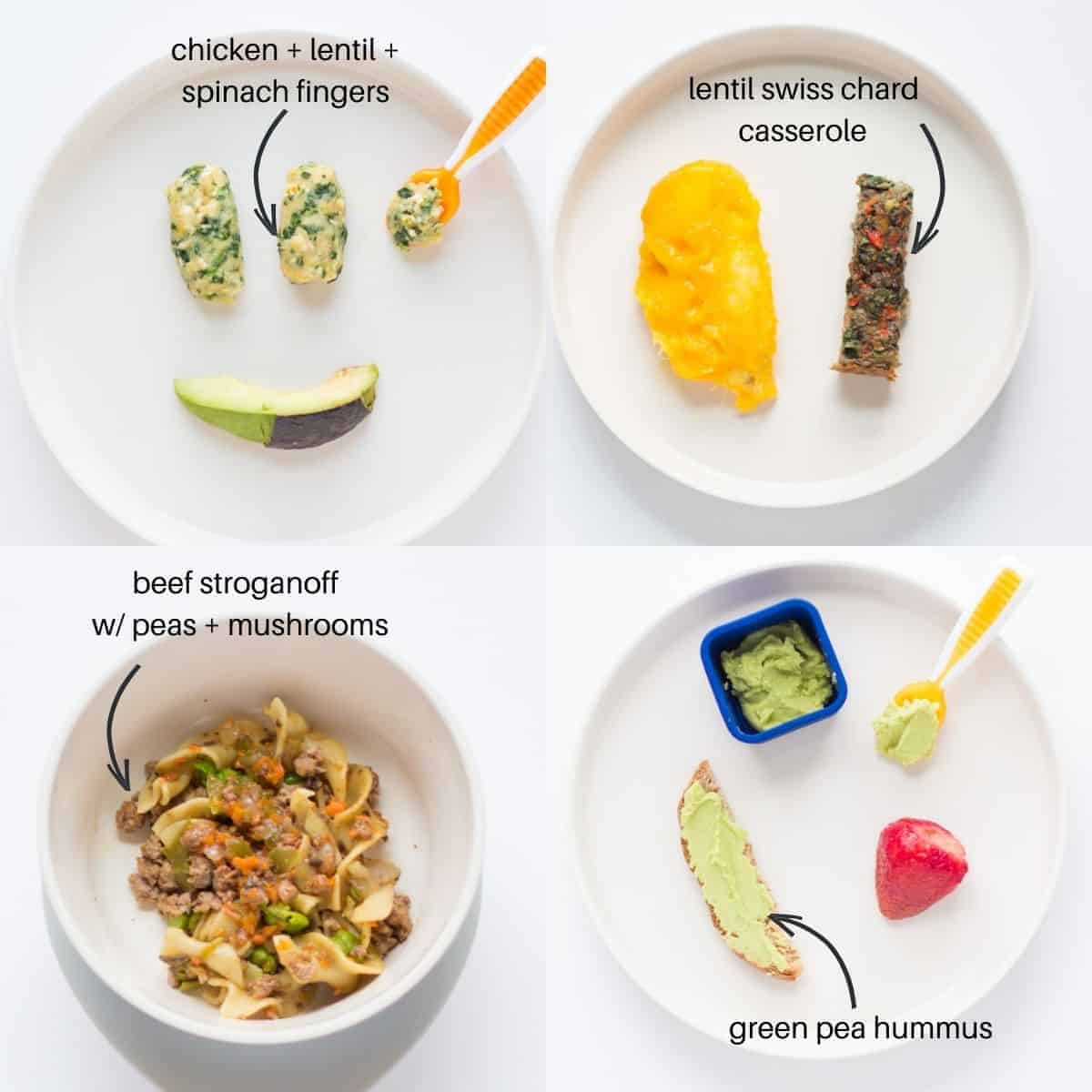
Table of Contents
- Why is Iron so Important?
- Is your baby 6 months old and up?
- How much iron does a baby and toddler need?
- Top Iron-Rich Foods for Babies
- Top Iron-Rich Foods for Toddlers and Kids
- Is your toddler becoming picky?
- Top Tips to help increase iron level
- Iron-Rich Food Ideas for Vegetarian Babies and Toddlers
- Frequently Asked Questions
- Iron Rich Breakfast for Babies and Toddlers
- Lunch or Dinner Ideas with Iron
- 3 Month Meal Plan for Babies
- Additional Feeding Resources
Why is Iron so Important?
Iron is essential for producing red blood cells that carry oxygen from the lungs to all parts of the body. It’s also important for optimal brain development.
Iron is also one of the primary reasons that we start solid foods when we do. Babies are born with iron stores built up during their time in the womb. And this is why moms need to maintain a healthy iron status during pregnancy.
But by 6 months of age, it becomes depleted. At the same time, their iron needs increase drastically to support their rapid growth and development.
Inadequate iron intake in infanthood and childhood can lead to cognitive, including decreased attention and memory, as well as behavioral impairment, such as delayed attention, social withdrawal, and learning difficulties.

Is your baby 6 months old and up?
Learn all the secrets to starting solids safely while optimizing nutrition!
How much iron does a baby and toddler need?
According to the American Academy of Pediatrics, babies 6-12 month olds need 11 mg of iron per day. Toddlers between the ages of 1 and 3 need 7mg of iron per day.
While there’s so much focus on iron for babies, toddlers deserve the same degree of attention. Research shows that this age group have the lowest daily iron intake of any age group across the lifespan.
To give you context:
- 3 ounces steak: 2.5 mg of iron
- 1/4 cup cannellini beans: 2 mg
- 1/2 of egg: .5 mg
- 3 tablespoons fortified infant oat cereal: 5 mg
- 3 ounces chicken liver: 9.9 mg
- 3 ounces salmon: .8 mg
- 1/4 cup cooked spinach: 2 mg
- 2 ounces chickpea pasta: 3 mg
- 1/4 cup raw tofu: 1.6 mg
- 1 teaspoon hemp seeds: .32mg
- 1/4 cup cooked lentils: 2 mg
- 2 tbs peanut butter: .6 mg
Now please don’t start calculating and keeping track of how much your baby is getting daily. Nor stressing about what inhibits iron and what doesn’t.
This will just drive you crazy and lead to lots of anxieties and worries, especially if you are doing baby led weaning and following your baby’s lead.
And don’t worry! Your baby won’t need 11 mg of iron right away. It is not like once your baby hits 6 months, their iron reserve is completely depleted. It’s a gradual process.
What I encourage you to do, once again, is focus on including an iron-rich food at every meal! All those little bites will add up. And as they have more practice with eating, they will be able to meet their iron needs.
Top Iron-Rich Foods for Babies
Click on any of the links to learn exactly how to cook and serve the specific food to your baby!
- Beef (pureed, ground, shredded, or big strip)
- Chicken (pureed, ground, shredded, or big strip)
- Lentils
- Beans (white beans, chickpeas, kidney beans are highest in iron)
- Tofu
- Baby Oatmeal
- Quinoa Baby Cereal
- Eggs
- salmon
- sardines
- Pumpkin seeds (finely ground or add to dips like this pumpkin seed hummus)
- Peas (mash or puree and spread onto toast)
- Sweet Potato (pureed, mashed, cut into big strips and rolled in hemp seeds)
Top Iron-Rich Foods for Toddlers and Kids
Given that toddlerhood is often associated with picky eating habits and selective eating, here are some fun and enjoyable ways to introduce iron-rich foods:
- Chicken nuggets
- Pumpkin seed hummus with crackers and vegetables (cucumber, bell peppers, tomatoes, etc.)
- Ants on a log with peanut/nut/seed butter, hemp seeds, and raisins
- Smoothies – like these green smoothies or fiber shake.
- Colorful skewers – thread small pieces of beef, chicken, or tofu, along with colorful veggies onto skewers
- Iron-fortified cereals with milk, hemp seeds or chia seeds, and vitamin-C rich fruits
- Sandwiches on whole grain bread with meats or spreads
- Pasta with iron-rich sauces, like this baby pasta, broccoli pesto, carrot pasta sauce, and sweet potato sauce
- Bliss balls – also try these apricot balls and peanut butter bliss balls
- Pizza Quesadilla
- Chia puddings

Is your toddler becoming picky?
Arm yourself with these strategies that will transform your mealtimes!
Top Tips to help increase iron level
- Iron from animal products (heme iron) is absorbed better in the body.
- Be sure to combine plant-based iron (non-heme iron) with vitamin-C rich foods.
- It’s true that calcium inhibits the absorption of iron, but there’s no need to go out of your way to make sure you absolutely don’t serve calcium-containing foods with iron-rich foods. There are so many factors that affect iron absorption. Calcium is just one of them. What I do recommend is to not serve both at every single meal. .
- For toddlers, don’t serve too much milk. It not only contains components that can inhibit the iron absorption but can be quite filling. As a result, they may eat less iron-rich foods.
- Choose fortified products, such as fortified infant cereal or bread.
- Use a cast iron pan: cooking foods in cast iron cookware may increase the iron content of meals by up to 16%
Best Vitamin C Rich foods
- Oranges
- Grapefruit
- Kiwi
- Strawberries
- Cantaloupe
- Mango
- Pineapple
- Plums
- Tomatoes
- Bell peppers
- Broccoli
- Brussels sprouts
- Kale
- Peas
- Squash
Iron-Rich Food Ideas for Vegetarian Babies and Toddlers
Again, ALWAYS pair non-heme iron sources with Vitamin C rich food. I can’t emphasize this enough!
- Pumpkin seed hummus spread on whole grain toast with strawberries
- Iron-rich sauce tossed with legume-based pasta
- Oatmeal with peanut butter, hemp seeds, and mango puree
- Mashed chickpeas with finely chopped kale and quinoa
- Tofu with broccoli and tomato
- Hummus spread on bell pepper strips
- Mashed edamame with sweet potatoes (as a finger food or mashed)
- Lentils with finely chopped broccoli, tahini, garlic powder
- Infant oatmeal cereal with ground flax seeds and sunflower seed butter
Frequently Asked Questions
As you can see, the recommended intake is really high relative to how much food they’re likely to eat. If you’ve decided to do baby led weaning, you may be especially concerned as not much food will actually make it into your baby’s belly during the first days, weeks of starting solids.
As long as you’re offering an iron-rich source at every meal along with breast milk and/or infant formula, your baby will likely continue to meet their needs as they wean.
However, it’s always best to consult with your healthcare provider, especially if your baby is not developmentally ready to start solids at around 6 months.
Routinely, hemoglobin levels are checked starting at 12 months, usually. But you can always ask to have it checked earlier and supplement accordingly.
What you don’t want to do is automatically supplement on your own as it can cause more harm than good, if not necessary. The same goes for toddlers. If they’ve become really fussy and rejects most or all iron-rich foods, then bring this up to your doctor.
It is true that Iron from heme found in animal sources is absorbed better than iron from non-heme or plant sources. There are also many compounds found in plant foods, such as phytates and tannins, that reduce iron absorption.
Therefore, the recommended dietary intake for iron for vegetarians is 1.8 times higher than for meat eaters.
Knowing this, If your family is a vegetarian, you may be concerned that your baby is at an even greater risk for iron deficiency.
However, the good news is there are so many great food sources, and with some planning, plant-based diets can be adequate in iron. Check out the tips section above.
Perhaps you were recommended by your doctor, family, or friends to start with iron-fortified rice cereal. This is outdated advice. While it is suitable, your baby does NOT need to start with rice cereal.
It’s also high in arsenic, which you want to try to limit as much as possible. That’s not to say you shouldn’t give your baby rice at all, as it is a main staple in so many cultures, but you do want to be mindful.
Having said this, fortified infant cereal is a great option to help meet your baby’s nutritional needs. Look for ones made with whole grains, like oat, barley, quinoa, and buckwheat.
Iron Rich Breakfast for Babies and Toddlers
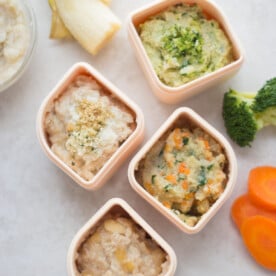
Easy Quinoa Baby Cereal (4 Ways)
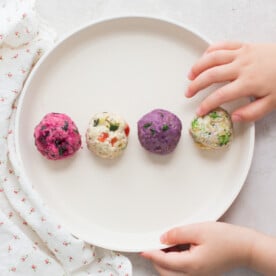
Homemade Baby Oatmeal

Healthy Pumpkin Oatmeal Bars
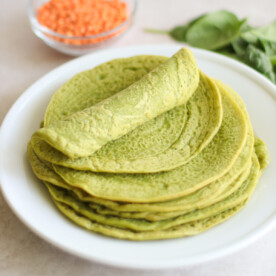
Lentil Wraps
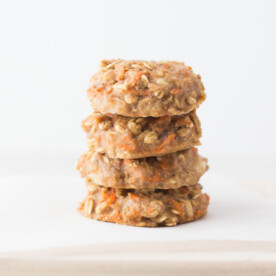
3 Ingredient Baby Cookies

2 minute egg oatmeal
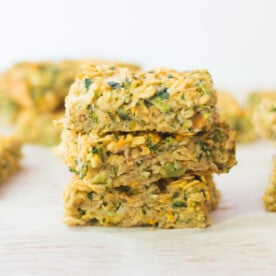
Savory Baked Oatmeal with Vegetables

Pumpkin Seed Spinach Hummus

Vegan vegetable quinoa muffins
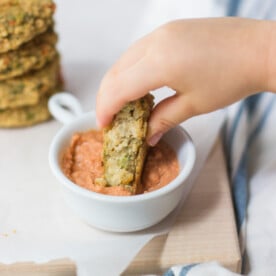
Chickpea Patties (gluten free)
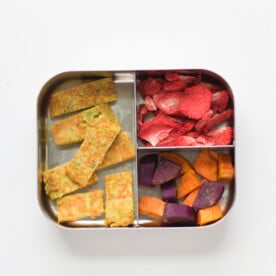
Vegetable Omelette

Healthy Sweet Potato Cookies

Healthy Beet Muffins for Babies
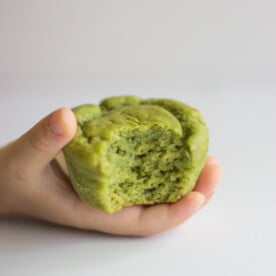
Moist Spinach Muffins

Healthy Pumpkin Banana Muffins

Beetroot Dip with chickpeas

Tofu Veggie Scramble

Overnight Quinoa Oats

Egg-Free Carrot Lentil Bars

Broccoli Pesto Pasta
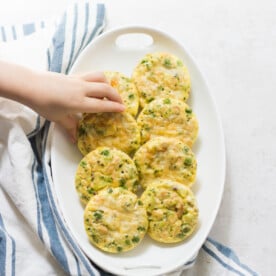
Mini crustless quiche

Mexican Lentil Muffins
Lunch or Dinner Ideas with Iron
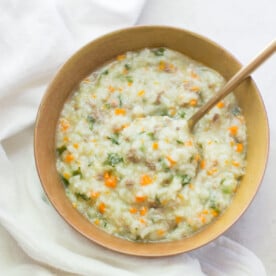
rice porridge for babies
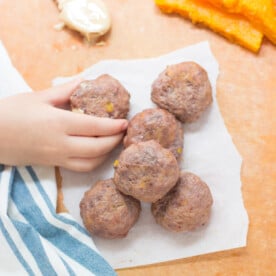
Healthy Baby Meatballs

Baked Quinoa and Mushroom Beef Meatballs

How to Cook Chicken for Babies

How to Roast a Turkey Breast
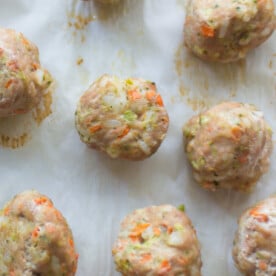
Turkey Meatballs with rice

Kid-friendly Turkey Beet Meatballs

Mini Shepherd’s Pie Muffins
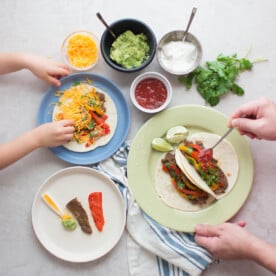
Pressure Cooker Steak Fajitas
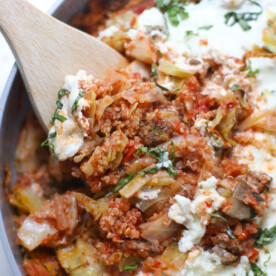
Skillet Cabbage Lasagna

Baby-Friendly Korean Bulgogi
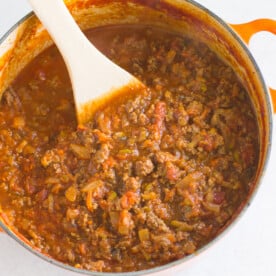
Easy Bolognese with Vegetables
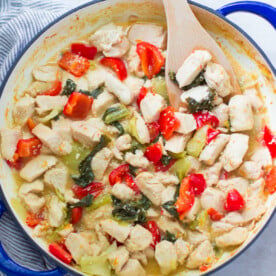
Orange Sesame Chicken with Vegetables

Low-Sodium Moo Goo Gai Pan

Vegetable Beef Soup with Cabbage

Homemade Hamburger Helper

Healthy Korean Beef and Broccoli Quinoa
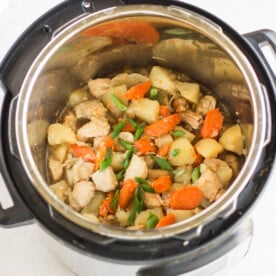
Instant Pot Korean Chicken and Potatoes

Healthy Sweet and Sour Meatball Stir-Fry

Easy Stuffed Shells with Meat

Low Sodium Baked Spaghetti Pie
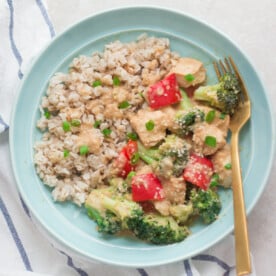
Instant Pot Peanut Chicken and Broccoli
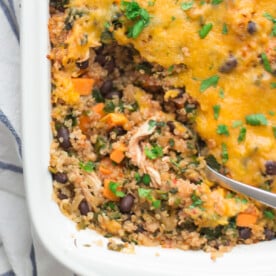
Chicken Spinach Quinoa Casserole
Vegetarian Iron Rich Recipes

Cooking Beans for Babies (3 Methods)
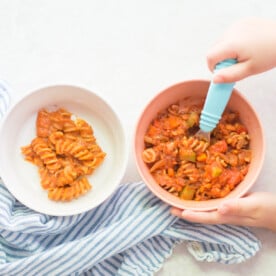

Carrot and Lentil Soup
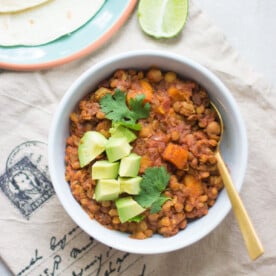
Slow Cooker Lentil Chili with Chickpeas

Teriyaki glazed salmon
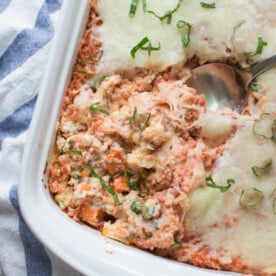
Vegetarian Sweet Potato Lasagna with Quinoa

How to Cook Tofu for Baby Led Weaning

Non-Spicy Korean Tofu Soup

Vegan Creamy Tomato Pasta

One Pot Mexican Lentils

Easy baked shrimp cakes

Easy Salmon Bean Salad

Eggplant Lasagna Roll-Ups
3 Month Meal Plan for Babies
All the images of baby plates you see in this post are exactly what I served my daughter during our first three months of starting solids.
From speaking to hundreds of parents and caregivers, it was clear that the greatest challenge is how to ensure their baby is getting optimal nutrition while trying to juggle everything and get through the day.
It can feel so overwhelming and frustrating. And that’s why I created my 3 month program – Baby Led Feeding Journey.
I’m here to hand you a complete roadmap. Everything all in one place.
There’s SO much this program offers but don’t take my word for it. You can find out more here as well as hear from other moms who’ve gone through it.

Do you want to minimize picky eating and set a solid foundation for a lifetime of healthy eating habits?
Check out this 3 month mastering self-feeding program! It’s the closest thing to me being in your kitchen

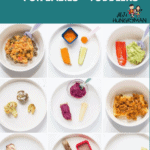













Hi! Love this post and all the info! Thank you 😊 Where can I find the chicken lentil spinach fingers recipe?
I’m so happy to hear that it was helpful! Oh there’s no real recipe but here’s how to make it just combine cooked lentils with chopped chicken and spinach and shape into fingers with your hand. Check out this post on lentils for babies to learn how to cook lentils perfectly.
This couldn’t have come across my inbox at a better time! As a mama who battles iron-deficiency anemia, I love to incorporate more meals and recipes rich in iron for myself and two toddlers. But our variety is not perfect so I found this incredibly helpful!
Ooh! Just in time! Love hearing that. Please don’t hesitate to reach out if you have any questions or recipe requests 😉
Hi, do you have the recipe for the tofu black bean oatmeal ball or any of the tofu balls? Would love to try to make it for my 10 month daughter. Looked everywhere on your page but couldn’t find recipe.
Thanks!
HI so what I did was combine the leftover tofu veggie scramble with cooked oatmeal and shape into balls!